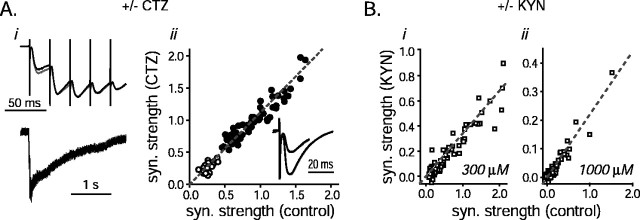Fig. 6.
CTZ and KYN do not affect short-term depression. Ai, Forty Hertz stimulation. Schaffer collaterals were stimulated 80 times at 40 Hz in the presence and absence of 100 μm CTZ. Average responses to the stimulus trains with (gray traces) and without (black traces; scaled by 1.12) CTZ are plotted (data are from 4 slices, 18 trials for each). The first six responses are plotted in the top panel. Note that CTZ amplified the first response slightly more than the rest, possibly because of presynaptic side effects of the drug. The entire electrophysiological recordings (the trace gathered in the absence of drug is scaled by 1.12), with the stimulus artifacts blanked (2 msec windows), are plotted in thebottom panel. Aii, Twenty Hertz and frequency switching. Schaffer collaterals were stimulated 60 times at 20 Hz and then 21 more times at 40 Hz as in Figure1A in the presence and absence of 100 μm CTZ. The size of the synaptic response to each stimulus was normalized by the average size of the first control response (no drug). The size of each response recorded in CTZ is plotted against the size of the corresponding control response to the same stimulus number (open circles represent responses at 40 Hz; filled circles are 20 Hz responses). Thedashed gray line is straight, with a slope of 1.12 (3 slices, 10 trials each). Inset, The average current traces representing the responses to the 20 stimuli preceding and after the frequency switch for each condition are overlaid (the response recorded in the absence of drug was scaled by 1.12; the larger of the two sets of current deflections represents responses recorded at 20 Hz; the baseline of the 40 Hz response average was calculated and subtracted as for the inset of Fig.1A). Note that the scaled responses with and without drug are identical and that the average 40 Hz response size is approximately half that recorded at 20 Hz. B, Schaffer collaterals were stimulated at least 80 times at 40 Hz alternately in the presence and absence of KYN (300 μm: 3 slices, 22 trials each; 1000 μm: 3 slices, 10 trials each). The normalized sizes of the control responses are plotted against the corresponding sizes of the responses gathered with KYN in the bath for each stimulus (i, 300 μm KYN;ii, 1000 μm KYN). The dashed lines are straight with slopes of 0.34 (i) and 0.22 (ii).

